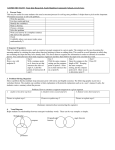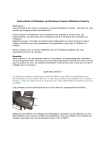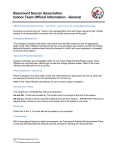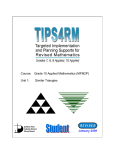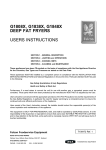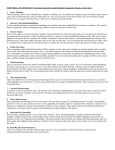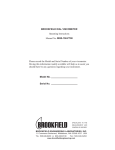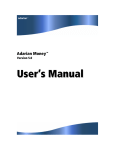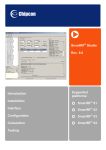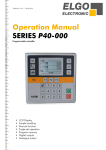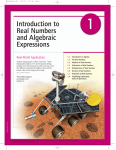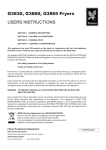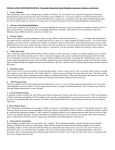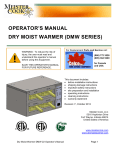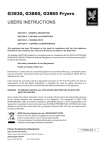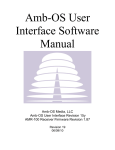Download Unit 4
Transcript
Course: Grade 10 Applied Mathematics (MFM2P) Unit 4: Linear Systems Unit 4- Linear Systems Section Activity Nspire CAS Manual Page 3 4.1.1 Working on Commission 7 4.1.2 What’s My Equation? 9 4.1.3 Meaning of he Point of Intersection 14 4.2.1 A Visual Cell Phone Problem 16 4.2.2 Music is My Best Friend 17 4.2.3 Where Do We Meet? 18 4.2.4 Does This Line Cross? 20 4.2.5 Is This Accurate? 21 4.3.1 What’s My POI? 22 4.3.2 A Better Way 23 4.3.3 Putting the Pieces Together 24 4.3.4 The “Sub” Way 25 4.3.5 What’s My Equation? Part 2 26 4.4.1 The Lowdown on Downloads 28 4.4.2 Putting the Process Together 29 4.4.3 An Interesting Problem 31 4.4.4 The Sub Steps 33 4.5.1 A Trip to Jim Hortons 34 4.5.2 An Elimination Introduction 35 4.5.3 Solving a Linear System by Elimination 36 4.6.1 What’s the Difference? 37 4.6.2 Elimination Preparation 38 4.6.3 Algebra, the Musical – Redux 39 4.6.4 Two for You 40 4.6.5 Help an Absent Friend 41 4.6.6 “Here’s to the Crazy Ones” 42 4.7.3 Which Method? 44 4.7.4 The Frayer Model 47 4.7.5 3 Ways 48 4.S Unit Summary 52 4.R Reflecting on My Learning (3, 2, 1) 53 4.RLS Reflecting on Learning Skills 54 TIPS4RM Grade 10 Applied: Unit 4 – Linear Systems (August 2008) 4-2 Nspire CAS Handheld Manual Getting Started When you turn on the handheld, press /N. You will be asked whether you want to save the document. Select No. To do this, use the large circular “navpad” to move to the right, then press the xbutton in the middle of the navpad. Next select 1:Add Calculator. To do this, press the x button again. You are now ready to use CAS on the handheld. Some Helpful Shortcuts If you make a mistake at any point that you want to undo, press /Z. If you undo something that you want back again, press /Y. How to Solve for a Variable: Example One Say that you wish to solve the equation 6x – 2y = 16 for the variable y. To do this, first be certain that you are on a Calculator page. If you need help with this, see the Getting Started section above. First type in the equation that you want to solve. Use the number pad and the green letter keys; the operations ( ÷ , × , -, + ) are located on the right, and the equals sign ( = ) is in the top-left corner of the keypad. When you have typed in the equation, press the · key, found in the bottom-right corner. The top of your screen will look something like this: Now decide how you would start in solving for y. Perhaps you’ve decided that subtracting 6x from both sides of the equation is a good start. Wonderful! To do this, immediately press -6X. Notice that the handheld automatically inserts Ans . What is this? Ans stands for the last answer you found. If you now press the · key, the handheld will subtract 6x from the left side and the right side of 6x - 2y = 16. You will see this result: Continue solving the equation. You probably see that to finally isolate the y variable, it is necessary to divide the equation by -2 on both sides. Again, just start typing the operation you want to perform. Press pv2. The handheld will insert Ans for you. Press · to calculate the result. As you can see, the handheld reports that y = 3x - 8 . TIPS4RM Grade 10 Applied: Unit 4 – Linear Systems (August 2008) 4-3 Nspire CAS Handheld Manual (Continued) How to Solve for a Variable: Example Two Say that you wish to solve the equation 6x + 2y = 18 for the variable y. To do this, first be certain that you are on a Calculator page. If you need help with this, see the Getting Started section above. First type in the equation that you want to solve. Use the number pad and the green letter keys; the operations ( ÷ , × , -, + ) are located on the right, and the equals sign ( = ) is in the top-left corner of the keypad. When you have typed in the equation, press the · key, found in the bottom-right corner. The top of your screen will look something like this: Now decide how you would start solving for y. Perhaps you’ve decided that subtracting 6x from both sides of the equation is a good start. Wonderful! To do this, immediately press -6X. Notice that the handheld automatically inserts Ans . What is this? Ans stands for the last answer you found. If you now press the · key, the handheld will subtract 6x from the left side and the right side of 6x + 2y = 18. You will see this result: Continue solving the equation. You probably see that to finally isolate the y variable, it is necessary to divide the equation by 2 on both sides. Again, just start typing the operation you want to perform. Press p2. The handheld will insert Ans for you. Press · to calculate the result. As you can see, the handheld reports that y = -3(x-3) . Is this the result you expected? Your teacher will discuss this with your class. After the discussion, use the space below to write your own explanation of what this means: ____________________________________________________________________________ ____________________________________________________________________________ ____________________________________________________________________________ ____________________________________________________________________________ TIPS4RM Grade 10 Applied: Unit 4 – Linear Systems (August 2008) 4-4 Nspire CAS Handheld Manual (Continued) How to Check a Solution to a Linear System Say that you have solved the following linear system: 4x + 2y = 24 8x - 6y = 18 ⎛9 ⎞ and you believe the solution is ⎜ , 3 ⎟ . ⎠ ⎝2 This would be tedious to check by pencil and paper, but it is quick to check with the handheld. Here is how to do it. First be certain that you are on a Calculator page. If you need help with this, see the Getting Started section from earlier in this manual. You are going to press the following keys to check the solution against the first equation: 4X+2Y=24*X=9p2_AND_Y=3 This means: “Check this equation such that x = 9 and y = 3.” 2 Don’t forget to press the _ key (lower-right corner of keypad) before and after the AND. Here is what it will look like on your handheld screen: To have the handheld check the solution, press the · key. If the solution is correct, the handheld will return the result “true”. If the solution is not correct, the handheld will report “false”. ⎛9 ⎞ You should find that the handheld reports that ⎜ , 3 ⎟ is a correct solution for the first equation. ⎠ ⎝2 Remember, it is necessary to check the solution in the second equation as well. It works the same way as before, but you can save some typing! Use the circular “navpad” and press up twice. The first command you entered is highlighted. Now press the · key. The handheld copies the command down to the line you are working on. You can now use the navpad to move left until the cursor is behind the * symbol. It looks like this: Press the . key to erase the first equation, then type the second equation. Then press ·. ⎛9 ⎞ As you can see, ⎜ , 3 ⎟ is a correct solution for the ⎝2 ⎠ second equation as well. Since the solution is correct for both equations from the linear system, we know it must be the right answer. TIPS4RM Grade 10 Applied: Unit 4 – Linear Systems (August 2008) 4-5 Nspire CAS Handheld Manual (Continued) How to Add or Subtract Two Equations The elimination method for solving a linear system involves adding or subtracting the given equations. Say that you are considering the following linear system: 3x + 2y = 16 5x - 2y = 8 You probably agree that if we add these two equations, the y variable will be eliminated. Here is how to do this on a handheld. First be certain that you are on a Calculator page. If you need help with this, see the Getting Started section from earlier in this manual. When you type in the equations, be certain to enclose them in brackets. Remember that we decided to add the equations. Here are the keys you should press: (3X+2Y=16)+(5X-2Y=8) It will look like this on your handheld: Press the · key. The handheld will display the result: You have eliminated the y variable. Subtracting two equations works the same way as adding two equations. The key is to remember that you must enclose each equation in brackets when you type it into the handheld. How to Multiply to Find an Equivalent Equation Consider the following linear system: 2x - 5y = 7 6x + 3y = 3 If we immediately add or subtract the equations, neither the x or the y variable is eliminated. Instead, we must multiply one of the equations by an integer so that the coefficients match. Then, if we subtract the equations, a variable will be eliminated. Let’s multiply the first equation by 3. Remember that all terms on both sides of the equation must be multiplied by 3, so that the equation stays balanced. Here is how to do this on a handheld. First be certain that you are on a Calculator page. If you need help with this, see the Getting Started section from earlier in this manual. Press the following keys: 3r2X+3r-5Y=3r7 What you have typed should look like this: Press the · key. The handheld will display the result: Now we have a system that we can begin to solve by subtracting the equations: TIPS4RM Grade 10 Applied: Unit 4 – Linear Systems (August 2008) 6x - 15y = 21 6x + 3y = 3 4-6 4.1.1: Working on Commission Nahid works at Euclid’s Electronics. She is paid a salary of $200 per week plus a commission of 5% of her sales during the week. The equation P = 0.05s + 200 , represents Nahid's pay for the week where P represents the total pay for the week and s represents her total sales. Use your handheld to help you solve. Refer to the user manual if you need to review how to solve using the handheld. Week's Pay ($) If Nahid earned $290 in a week use the equation to algebraically determine how much she sold. Total Value of Sales ($) Nahid is offered another job at Fermat's Footwear, where the pay is a salary of $100 per week and 10% commission on all sales. The graph below represents the Pay vs. Sales for this job. Which of the following equations do you think represents pay for one week at Fermat's Footwear? a) P = 0.01s + 100 c) P = 100s + 10 d) P = 0.05s + 200 Provide a reason or justify why you selected the equation that you chose. Refer back to the equation for Euclid's Electronics for hints. Week's Pay ($) b) P = 0.10s + 100 Total Value of Sales ($) TIPS4RM Grade 10 Applied: Unit 4 – Linear Systems (August 2008) 4-7 Nahid needs help determining which job she should keep. She decides to look at them as a system of equations when she creates a graph comparing the two equations at the same time. Analyze the graph and complete the questions below. Week's Pay ($) 4.1.1: Working on Commission (Continued) _____ Euclid's Electronics .…….. Fermat's Footwear Total Value of Sales($) 1. Where the two lines cross is called the point on intersection, or the solution to the system. At what coordinates do the two lines cross? 2. What does this coordinate represent in terms of Nahid's sales, and pay for the week? 3. If Nahid usually makes $1500 worth of sales per week, which job should she take? Explain. 4. How does the graph help Nahid determine which is the better job? 5. What does the point (1000, 250) represent in the graph? TIPS4RM Grade 10 Applied: Unit 4 – Linear Systems (August 2008) 4-8 4.1.2: What’s My Equation? You are given four problems below. Each problem will require two equations to solve it. The equations that are needed to solve each problem appear at the bottom of the handout. Match the equations with the problems and compare your answers with another student. Note: There are more equations than problems and all the equations use x for the independent variable and y for the dependent variable. Problem A: Equations Yasser is renting a car. Zeno Car Rental charges $45 for the rental of the car and $0.15 per kilometre driven. Erdos Car Rental charges $35 for the rental of the same car and $0.25 per kilometre driven. Which company should Yasser choose to rent the car from? Equations Problem B: The school council is trying to determine where to hold the athletic banquet. The Algebra Ballroom charges an $800 flat fee and $60 per person. The Geometry Hall charges a $1000 flat fee and $55 per person. Which location should the school council select for the athletic banquet? Equations Problem C: The yearbook club is considering two different companies to print the yearbook. The Descartes Publishing Company charges a flat fee of $475 plus $4.50 per book. School Memories charges a flat fee of $550 plus $4.25 per book. Which company should the yearbook club select to print this year’s yearbook? Problem D: Equations The school is putting on the play “Algebra: The Musical”. Adult tickets were sold at a cost of $8 and student tickets were sold at a cost of $5. A total of 220 tickets were sold to the premiere and a total of $1460 was collected from ticket sales. How many adult and student tickets were sold to the premiere of the musical? EQUATIONS: 1. y = 4.50 + 475x 2. 60 + 800x = y 3. y = 1000 + 55x 4. x = 45 + 0.15x 5. y = 1000x + 55 6. y = 45 + 0.15x 7. x + y = 220 8. 5x + 8y = 220 9. y = 4.25x + 550 10. y = 550x + 4.25 11. y = 800 + 60x 12. x + y = 1460 13. y = 0.25x + 35 14. y = 4.50x + 475 15. y = 35x + 0.25 16. 5x + 8y = 1460 TIPS4RM Grade 10 Applied: Unit 4 – Linear Systems (August 2008) 4-9 4.1.2: What’s My Equation? (Continued) Problem A: Yasser is renting a car. Zeno Car Rental charges $45 for the rental of the car and $0.10 per kilometre driven. Erdos Car Rental charges $35 for the rental of the same car and $0.25 per kilometre driven. Which company should Yasser choose to rent the car from? To solve the question, complete the table of values, and the graph. Distance (km) 0 10 20 30 40 50 60 70 80 90 100 Erdos Cost Distance (km) Cost 0 10 20 30 40 50 60 70 80 90 100 Cost ($) Zeno Kilometers Driven 1. How can the car rental cost and the cost per kilometre be used to draw the graph? 2. What is the point of intersection of the two lines? What does it represent? 3. Under what conditions is it best to rent from Zeno Car Rental? 4. Under what conditions is it best to rent from Erdos Car Rental? TIPS4RM Grade 10 Applied: Unit 4 – Linear Systems (August 2008) 4-10 4.1.2: What’s My Equation? (Continued) Problem B: The school council is trying to determine where to hold the athletic banquet. The Algebra Ballroom charges an $800 flat fee and $60 per person. The Geometry Hall charges a $1000 flat fee and $55 per person. Which location should the school council select for the athletic banquet? To solve the question, complete the table of values, and the graph. Number of People 0 10 20 30 40 50 60 70 80 90 100 Cost Geometry Hall Number of People Algebra Ballroom vs. Geometry Hall Cost 0 10 20 30 40 50 60 70 80 90 100 Cost ($) Algebra Ballroom Number of People 1. How can the flat fee and the per person cost be used to draw the graph? 2. What is the point of intersection of the two lines? What does it represent? 3. Under what conditions is it best to go with Algebra Ballroom? 4. Under what conditions is it best to go with Geometry Hall? TIPS4RM Grade 10 Applied: Unit 4 – Linear Systems (August 2008) 4-11 4.1.2: What’s My Equation? (Continued) Problem C: The yearbook club is considering two different companies to print the yearbook. The Descartes Publishing Company charges a flat fee of $475 plus $4.50 per book. School Memories charges a flat fee of $550 plus $4.25 per book. Which company should the yearbook club select to print this year’s yearbook? Descartes Cost 0 50 100 150 200 250 300 350 400 450 500 Number of Books School Memories Number Cost of Books 0 50 100 150 200 250 300 350 400 450 500 Cost ($) To solve the question complete the table of values, and the graph. Number of Books 1. How can the flat fee and the cost per book be used to draw the graph? 2. What is the point of intersection of the two lines? What does it represent? 3. Under what conditions is it best to go with Descartes Publishing? 4. Under what conditions is it best to go with School Memories? TIPS4RM Grade 10 Applied: Unit 4 – Linear Systems (August 2008) 4-12 4.1.2: What’s My Equation? (Continued) Problem D: The school is putting on the play “Algebra: The Musical”. Adult tickets were sold at a cost of $8 and student tickets were sold at a cost of $5. A total of 220 tickets were sold to the premiere and a total of $1460 was collected from ticket sales. How many adult and student tickets were sold to the premiere of the musical? To solve the question complete the table of values, and the graph. x 0 40 80 120 160 200 y x 0 40 80 120 160 200 y Number of Adult Tickets Let x represent the # of student tickets sold Let y represent the # of adult tickets sold Number of Student Tickets 1. What is the approximate point of intersection of the two lines? What does it represent? 2. Does the rest of the graph (other than the POI) give us any information about the number of tickets sold? TIPS4RM Grade 10 Applied: Unit 4 – Linear Systems (August 2008) 4-13 4.1.3: Meaning of the Point of Intersection 1. Your family wants to rent a car for a weekend trip. Cars R Us charges $60.00 per weekend for a midsize car plus $0.20 per km. Travel With Us charges $0.50 per km. a. Graph both options on the grid and determine the number of kilometres where both companies will cost the same amount. b. Explain what this means for your weekend trip. 2. Anthony and Anne are bicycling at a Provincial Park. Anthony travels at the rate of 10 km/hr and begins 2 km from the park entrance. Anne begins at the park entrance and travels at a rate of 15 km/hr. They both travel at a constant rate towards the Outdoor Education Centre. Graph both routes on the grid and determine the meaning of the point of intersection. TIPS4RM Grade 10 Applied: Unit 4 – Linear Systems (August 2008) 4-14 4.1.3: Meaning of the Point of Intersection (Continued) 3. For a car wash fundraiser Team A washes 2 cars per hour starting a 7:00 a.m. Team B begins washing cars at 9:00 a.m. and washes 3 cars per hour. Graph the car washing progress of each team on the grid and determine the meaning of the point of intersection, as well as the meaning of the points before and after the point of intersection. TIPS4RM Grade 10 Applied: Unit 4 – Linear Systems (August 2008) 4-15 4.2.1: A Visual Cell Phone Problem Cost ($) Two cell phone companies charge a monthly flat fee plus an additional cost for each minute of time used. The graph below shows the Time vs. Cost relationship, for one month. ____ Talk More …… We Talk Time (minutes) 1. What is the Point of Intersection (POI), and what is the meaning of the POI in relation to the cell phone plans? 2. Under what conditions is it best to use the Talk More cell phone plan? 3. Under what conditions is it best to use the We Talk cell phone plan? 4. How does the graph help you to determine which cell phone plan is the most appropriate at any given time? TIPS4RM Grade 10 Applied: Unit 4 – Linear Systems (August 2008) 4-16 4.2.2: Music is My Best Friend iTones and Music Mine are two online music providers. Each company charges a monthly membership fee and then a per song download rate. iTones charges $10 per month, and $1 per song Music Mine charges $7 per month and $1.50 per song. C = n + 10 C = 1.5n + 7 Where C represents the total cost for one month and n represents the number of songs purchased. Create a table of values showing the total charges for up to 8 songs purchased. Graph the lines on the same graph below. iTones C n 0 1 C Cost ($) N 0 1 Music Mine Number of Songs 1. If Lulu plans to purchase 7 songs this month, which is the best plan for her? Explain. 2. Which plan is cheaper if you only plan to buy 4 songs per month? How do you know from the graph? 3. Which cell phone plan would you choose and why? Relate your answer back to the POI. TIPS4RM Grade 10 Applied: Unit 4 – Linear Systems (August 2008) 4-17 4.2.3: Where Do We Meet? For each of the following situations, find the point of intersection and describe the meaning of this point. Describe which company or service you would choose under what circumstances. A template has been provided for the first situations. A B Point of intersection:_____________ Cost ($) Interpretation of the point: If the job lasts less than _____ hours, choose ______. If the job lasts more than ______ hours, choose _______. If the job lasts _______ hours, choose either company and the cost is______ Time (hours) Point of intersection:_____________ Cost ($) Interpretation of the point: A B If the kilometers driven is less than _____, choose ______. If the kilometers driven is more than ______, choose _______. If the kilometers driven is _______, choose either company and the cost is______ Kilometers Driven TIPS4RM Grade 10 Applied: Unit 4 – Linear Systems (August 2008) 4-18 4.2.3: Where Do We Meet? (Continued) For each of the following situations, find the point of intersection and describe the meaning of this point. Refer back to the template provided for the first situations. A B Point of intersection:_____________ Cost ($) Interpretation of the point: Time (hours) Point of intersection:_____________ C Interpretation of the point: Cost ($) B A Talking Time (hours) TIPS4RM Grade 10 Applied: Unit 4 – Linear Systems (August 2008) 4-19 4.2.4: Does This Line Cross? From the list of relations below, determine which lines cross through the point (2,3). You may use the graph to assist you. 1. y = 2 x + 3 2. y = x + 1 3. y = −2 x + 7 4. y = −3 5. x = 2 6. y = 2 Questions: 1. Which of the lines passes through the point (2,3)? 2. Is there another way to determine if the line passes through the point, other than graphing? Explain. 3. Without graphing, how can you quickly determine if a horizontal or vertical line passes through a point? 4. Other than the point (2, 3), what are the other points of intersection on your graph? 5. Is it possible for two lines to have more than one point of intersection with each other? Discuss this with your partner. TIPS4RM Grade 10 Applied: Unit 4 – Linear Systems (August 2008) 4-20 4.2.5: Is this Accurate? 1. Find the point of intersection. (Solve the system using graphical method.) a) y = 2x + 1 b) y = -x -2 y = 3x – 2 y = 2x + 7 Point of intersection is :_______________ Point of intersection is:________________ c) d) y = 2x + 1 y = 4x – 4 Point of intersection is :_______________ y = -5 y = -3x+2 Point of intersection is :_______________ TIPS4RM Grade 10 Applied: Unit 4 – Linear Systems (August 2008) 4-21 4.3.1: What’s my POI? • • • Each one of you will solve one of the systems of equations given below. Once you have solved the system you were assigned, trade with your partner and check their solution. Share your feedback with your partner. Once you have shared your feedback and are confident in the solutions to the systems, post your point of intersection under the appropriate heading on the class list. System A System B 1 x −1 2 y = −3x + 4 y = 2x + 7 y= Point of Intersection: ( y = −3 x + 4 , ) TIPS4RM Grade 10 Applied: Unit 4 – Linear Systems (August 2008) Point of Intersection: ( , ) 4-22 4.3.2: A Better Way Solve the following systems of equations algebraically. Use your CAS handheld to solve and check if needed. 1. Equation 1: y + 2 = 10 and Equation 2: x + y = 12 Point of intersection: (____, ____) 2. Equation 1: 3x + 2y =33 and Equation 2: 2x = x + 7 Point of intersection: (____, ____) In each of the systems you solved above, which equation did you choose to solve first? Why did you select that equation in each case? TIPS4RM Grade 10 Applied: Unit 4 – Linear Systems (August 2008) 4-23 4.3.3: Putting the Pieces Together System 1: y = 2x + 7 and y = -3x + 4 Record the line that results once you have substituted, and then solve the equation using your CAS handheld. Resulting equation and my solution. (Don’t forget to solve for both variables.) Check your solution using the CAS handheld. Compare your solution to someone else in the class. System 2: -2x + y = 0 and x - y = 12 Record the line that results once you have substituted, and then solve the equation using your CAS handheld. Resulting equation and my solution. (Don’t forget to solve for both variables.) Check your solution using the CAS handheld. Compare your solution to someone else in the class. TIPS4RM Grade 10 Applied: Unit 4 – Linear Systems (August 2008) 4-24 4.3.4: The “Sub” Way • • • In groups of three, have each person in the group solve one of the systems below. Use your CAS handheld to help you solve and check your system. Share your solutions with each person in the group. System A y = 4x + 24 and y = -5x – 12 System C y = -x – 8 and y = -5x System B 13x + y = – 4 and 5x + y + 4 = 0 Challenge CHALLENGE: Plot each of the POI's from Systems A, B, and C and find the equation of the line that connects the three points. Equation of Line:_____________________ TIPS4RM Grade 10 Applied: Unit 4 – Linear Systems (August 2008) 4-25 4.3.5: What’s My Equation? - Part 2 Part A Let’s return to our application problems that we solved graphically earlier in the unit. Assign each person in your group one of the three problems to solve. Solve these application problems using the method of substitution introduced today. Use the CAS handheld to help you solve. Problem A: Yasser is renting a car. Zeno Car Rental charges $45 for the rental of the car and $0.15 per kilometre driven. Erdos Car Rental charges $35 for the rental of the same car and $0.25 per kilometre driven. For what distance do the two rental companies charge the same amount? Equations y = 45 + 0.15x y = 35 + 0.25x Problem B: The school council is trying to determine where to hold the athletic banquet. The Algebra Ballroom charges an $800 flat fee and $60 per person. The Geometry Hall charges a $1000 flat fee and $55 per person. For what amount of guests do the two banquet halls charge the same amount? Equations y = 60x + 800 y = 55x + 1000 Problem C: The yearbook club is considering two different companies to print the yearbook. The Descartes Publishing Company charges a flat fee of $475 plus $4.50 per book. School Memories charges a flat fee of $550 plus $4.25 per book. For what amount of books do the two companies charge the same amount? Equations y = 475 + 4.50x y = 550 + 4.25x ____________________________________________________________________________ I am solving problem ___: TIPS4RM Grade 10 Applied: Unit 4 – Linear Systems (August 2008) 4-26 4.3.5: What’s My Equation? - Part 2 (Continued) Part B Discuss the following questions with your group members. 1. Looking at your problem, how can you tell from the equation which company is cheaper before the point of intersection (where the costs are equal)? 2. Looking at your problem, how can you tell from the equation which company is cheaper after the point of intersection (where the costs are equal)? 3. Is this true for all problems? 4. Now that you’ve solved the problems using two different methods, which method do you prefer? Why? 5. When do you think solving by substitution would be preferable to solving by graphing? TIPS4RM Grade 10 Applied: Unit 4 – Linear Systems (August 2008) 4-27 4.4.1: The Lowdown on Downloads Let’s return to our music downloading problem. Here’s the problem again. iTones and Music Mine are two online music providers. Each company charges a monthly membership fee and then a per song download rate. iTones charges $10 per month, and $1 per song Music Mine charges $7 per month and $1.50 per song. C = x + 10 C = 1.5 x + 7 1. Find the number of songs that I would need to download where the costs are the same for the two music providers. 2. Paris solved the problem and then made the following conclusion: If you download less than 6 songs per month than choose iTones since the cost per song is less. If you download more than 6 songs per month than choose Music Mine since the fixed cost is less. If you download exactly 6 songs per month, choose either Is the conclusion that Paris made correct? If not, underline the part(s) of her conclusion that are incorrect and then rewrite it so that it is correct. TIPS4RM Grade 10 Applied: Unit 4– Linear Systems (July 2008) 4-28 4.4.2: Putting the Pieces Together (Continued) Solve the system: y = 10 – 2x and x – 2y = 10 The steps to the solution to this system are given in the pieces below. Cut the pieces out and glue them in the correct order on a separate piece of paper. Use the handheld to help you. Hint: There are 10 steps in the complete solution. x – 2(10 – 2x) = 10 –x = 20 x=6 Point of Intersection: (6,-2) x – 20 – 4x = 10 y = 10 – 12 y = 14 x – 10 – 2x = 10 y = -2 y = 10 – 2(6) 5x = 10 + 20 x = 30/5 –x = 10 + 10 5x = 30 x = -20 x – 20 + 4x = 10 x = -2 Point of Intersection: (-2,6) TIPS4RM Grade 10 Applied: Unit 4– Linear Systems (July 2008) 4-29 TIPS4RM Grade 10 Applied: Unit 4– Linear Systems (July 2008) 4-30 4.4.3: An Interesting Problem Consider the following three systems of equations: System A System B System C x + 2y = 3 and 4x + 5y = 6 -2x + y = 4 and 7x + 10y = 13 -5x – 3y = -1 and x + 3y = 5 1. In order to solve these systems by substitution, we need to first isolate one variable in one equation. Circle the variable in each system that would require just one step to isolate. Compare your choice with a neighbour. 2. Using your handheld to help you, isolate the variable you selected in #1 for each system. System A System B System C 3. Assign each system to one person in your group and solve the system assigned to you in the space below. Use your handheld to help solve and check. I am solving system _____: Point of Intersection (_____, _____) 4. Compare your solution to the rest of the group. What do you notice? TIPS4RM Grade 10 Applied: Unit 4– Linear Systems (July 2008) 4-31 4.4.3: An Interesting Problem (Continued) 5. The chart below lists out only the numbers that appear in each system. What do you notice about the numbers in each system? System A System B System C 1, 2, 3, 4, 5, 6 -2, 1, 4, 7, 10, 13 -5, -3, -1, 1, 3 , 5 6. Let’s see if this works with more systems. Each system below has only one equation given. Assign each system to one person in the group and create a second equation that will give the solution (-1, 2) when solved. System A Equation 1: x + 6y = 11 System B Equation 1: -14x – 9y = -4 System C Equation 1: 9x + 7y = 5 Equation 2: ____________ Equation 2: ____________ Equation 2: ____________ 7. Share your equation with everyone in the group and copy down the equations from the rest of the group. Review the equations created and make sure they follow the rule that you noted in #5. You will solve these three systems as a part of your home activity. TIPS4RM Grade 10 Applied: Unit 4– Linear Systems (July 2008) 4-32 4.4.4: The Sub Steps Solving using the method of substitution requires five steps. The steps are given below in the text boxes. Discuss with your partner what you think the correct order is for the steps and then write the steps in the space provided. Solve the system in the chart as model of solving by substitution. Check using your handheld. State the point of intersection. Substitute the isolated expression into the other equation. Solve the resulting equation. Substitute your solution into an original equation to solve for the other variable. Isolate for a variable. The easiest variable to isolate for has a coefficient of 1. Steps for Solving by Substitution TIPS4RM Grade 10 Applied: Unit 4– Linear Systems (July 2008) Example: Solve 4x + y = 6 and 2x – 3y = 10 4-33 4.5.1: A Trip to Jim Hortons It’s summer vacation. Ah, sweet freedom. The only problem is that you’re the designated coffee gopher at the office where you have a summer job. On Monday, you were sent out to Jimmies to pick up five small coffees and seven extra large coffees. You remember that the total cost was $14.95, including tax. On Tuesday, you were sent out to get three small coffees and seven medium coffees. You recall that the total came to $12.75, with tax. It’s Wednesday morning and your coffee crazy co-workers are calling for their cup o’ joe. Unfortunately, since the morning fix hasn’t arrived yet, no one can remember how much a small or extra large coffee costs, including yourself. You need to find out how much each size costs to collect the correct amount of money for the Wednesday coffee run. 1. Let s be the number of small coffees ordered on a single day. Let e be the number of extra large coffees ordered on a single day. As a class, can we decide on an equation to represent the purchases made on Monday, and an equation to represent the purchases made on Tuesday? Monday’s equation: ___________________________________________________ Tuesday’s equation: ___________________________________________________ 2. Now we have a linear system. Take a few minutes to solve the linear system using substitution in the space below. Then pair with another student to discuss your solution. 3. What problems, if any, did you encounter? TIPS4RM Grade 10 Applied: Unit 4– Linear Systems (July 2008) 4-34 4.5.2: An Elimination Introduction You know that two integers can be added, or subtracted: 5 + 7 12 15 − 6 9 In the same way, equations can be added, or subtracted: 10x + 20y = 80 − 10x + 15y = 25 3x + 2y = 19 + 5x − 2y = 5 8x 5y = 55 = 24 Notice that by adding the equations in the first linear system, the y variable was eliminated (there were 0y), which makes it possible to solve for x . By subtracting the equations in the second linear system, the x variable was eliminated (there were 0x), which makes it possible to solve for y . 1. 2. Work in pairs to consider the following linear systems. Decide what operation – addition or subtraction – would result in the elimination of a variable. You may use CAS on the handheld to help you decide. 9x + y = 4 14x + y = -1 3x - y = 50 12x + y = 115 -7x - 6y = 338 9x + 6y = -366 18x - 5y = 454 12x - 5y = 316 19x + 2y = 102 19x - 2y = 50 17x - 8y = 323 6x + 8y = 114 9x - 4y = 235 15x + 2y = 409 7x - 16y = 441 7x - 17y = 476 5x - 3y = 188 6x - 11y = 344 What needs to be true about a linear system so that a variable is eliminated when the equations are added or subtracted? TIPS4RM Grade 10 Applied: Unit 4– Linear Systems (July 2008) 4-35 4.5.3: Solving a Linear System by Elimination 1. How would you begin solving this linear system? Addition or Subtraction? 5x + 4y = 7 3x - 4y = 17 2. Solve the system. 3. In your own words, describe what you must do to solve a linear system by elimination. ________________________________________________________________________ ________________________________________________________________________ ________________________________________________________________________ ________________________________________________________________________ ________________________________________________________________________ ________________________________________________________________________ ________________________________________________________________________ ________________________________________________________________________ TIPS4RM Grade 10 Applied: Unit 4– Linear Systems (July 2008) 4-36 4.6.1: What’s the difference? Original equation: x + 2y = 6 Multiply the equation by the constant ______. The new equation is _____________________. Complete the table of values for your equation and plot the values on the grid provided. x -4 -2 0 2 4 y 10 8 6 4 2 -10 -8 -6 -4 -2 2 4 6 8 10 -2 -4 -6 -8 -10 TIPS4RM Grade 10 Applied: Unit 4– Linear Systems (July 2008) 4-37 4.6.2: Elimination Preparation 1. Consider the following linear system: 3k + 15m = − k − 15 m = −1 If you add or subtract the equations, will a variable be eliminated? Explain. 2. What could be done to create the conditions necessary for elimination? TIPS4RM Grade 10 Applied: Unit 4– Linear Systems (July 2008) 4-38 4.6.3: Algebra, the Musical - Redux Recall that in the first lesson of this unit, you solved the following problem by graphing: The school is putting on the play “Algebra: The Musical”. Adult tickets were sold at a cost of $8 and student tickets were sold at a cost of $5. A total of 220 tickets were sold to the premiere and a total of $1460 was collected from ticket sales. How many adult and student tickets were sold to the premiere of the musical? If x represents the number of student tickets sold, and y represents the number of adult tickets sold, then the equations that model this problem are: (from cost of tickets) (from number of tickets sold) 5x + 8y = 1460 x + y = 220 You probably remember that this problem took a while to solve by graphing, and the answer you found was not necessarily very accurate, since you read the point of intersection off of the graph. You will work with a partner now to solve this problem using the method of elimination. 1. Since you have been asked to eliminate the x or y variable (circle one) first, what will be the first step you take to create the conditions necessary for elimination? 2. Solve the linear system now. You may use CAS to help find the answer and check the solution. Use the space below for rough work. 3. Does it matter which variable is eliminated first? That is, does it change the final answer? 4. Think back to when you solved this problem by graphing. Do you find the method of elimination easier or harder? Explain. TIPS4RM Grade 10 Applied: Unit 4– Linear Systems (July 2008) 4-39 4.6.4: Two for You Try solving the following questions using the method of elimination. You may use CAS on the handhelds to help solve the questions and check your solutions. 1. A fitness club charges an annual fee and an hourly fee. In a single year, member A worked out for 76 hours and paid $277 in total. Member B worked out for 49 hours and paid $223 in total. What is the annual fee? What is the hourly fee? HINT: Start by writing “let” statements to define the variables you will use. For example: Let a represent the amount of the annual fee. Let h represent the amount of the hourly fee. 2. This past summer, you ran a food booth at a local festival. You sold hotdogs for $1 each and samosas for $2.50 each. From 205 purchases, you made $400 in total. To help plan purchases for next year’s festival, you’d like to know how many hotdogs and samosas were sold. Unfortunately, you forgot to keep track of this when selling the food. Can you determine how many hotdogs and samosas were sold? NOTE: Assume one hotdog or one samosa per purchase. TIPS4RM Grade 10 Applied: Unit 4– Linear Systems (July 2008) 4-40 4.6.5: Help an Absent Friend Consider the following linear system: 2x + 3y = 1 3x − y = 7 How would you solve it? Write in words a description of the steps you would take. To help you understand what to write, pretend for a moment that you are writing the instructions for a friend who is not in class today. What steps would you need to describe? TIPS4RM Grade 10 Applied: Unit 4– Linear Systems (July 2008) 4-41 4.6.6: “Here’s To The Crazy Ones” 1. Solve the following linear system by elimination: 4x + 2y = 12 8x + 4y = 32 2. Did you encounter any results that are unusual? Explain what is different compared to questions you have already solved. 3. Re-arrange each equation from the linear system into y = mx + b form, then graph. For example, here is how the first equation can be re-arranged: 10 8 4x + 2y = 12 2y = −4x + 12 6 2y 12 −4x = + 2 2 2 y = −2x + 6 4 2 -10 -8 -6 -4 -2 2 4 6 8 10 -2 -4 -6 -8 -10 4. What do you notice about the slope in each equation that you re-arranged? What do you notice about how the two lines visually relate to each other? Is there a solution to this linear system? TIPS4RM Grade 10 Applied: Unit 4– Linear Systems (July 2008) 4-42 4.6.6: “Here’s To The Crazy Ones” (Continued) 5. Solve the following linear system by elimination: 6x + 2y = 2 12x + 4y = 4 6. Did you encounter any results that are unusual? Explain what is different compared to questions you have already solved. 7. Re-arrange each equation from the linear system into y = mx + b form, then graph. 10 8 6 4 2 -10 -8 -6 -4 -2 2 4 6 8 10 -2 -4 -6 -8 -10 8. What do you notice about the slope and y-intercept in each equation that you re-arranged? What do you notice about how the two lines visually relate to each other? Is there a solution to this linear system? If so, how many? TIPS4RM Grade 10 Applied: Unit 4– Linear Systems (July 2008) 4-43 4.7.3: Which Method? Graphing: For System A determine if you can solve the system using each of the three methods you have learned, and if you can, then solve. 2 x + 3 y = 10 − 4x + 5 y = 2 Justify why you can or cannot solve using this method. Justification: Substitution: Elimination: Justification: Justification: TIPS4RM Grade 10 Applied: Unit 4– Linear Systems (July 2008) 4-44 4.7.3: Which Method? (Continued) Graphing: For System B determine if you can solve the system using each of the three methods you have learned, and if you can, then solve. y = x−2 x + 5 y = −4 Justify why you can or cannot solve using this method. Justification: Substitution: Elimination: Justification: Justification: TIPS4RM Grade 10 Applied: Unit 4– Linear Systems (July 2008) 4-45 4.7.3: Which Method? (Continued) Graphing: For System C determine if you can solve the system using each of the three methods you have learned, and if you can, then solve. y = 2x − 7 y = −4 x + 5 Justify why you can or cannot solve using this method. Justification: Substitution: Elimination: Justification: Justification: TIPS4RM Grade 10 Applied: Unit 4– Linear Systems (July 2008) 4-46 4.7.4: The Frayer Model Definition Facts/Characteristics Examples Non-Examples TIPS4RM Grade 10 Applied: Unit 4– Linear Systems (July 2008) 4-47 4.7.5: 3 Ways Two catering companies provide food and the banquet hall for weddings, proms and anniversaries. Nick and Heather are getting married in September and they have two catering companies to choose from: Cookie’s Catering Cesaer Salad Chicken Picatta Roasted Potatoes Steamed Vegetables Sherbert Coffee or Tea The cost(C) for the different menu options includes the cost of the hall rental and price per person(n). Frugal Gourmet Minestrone Soup Mixed green salad Prime Rib Garlic Mashed Potatoes Asparagus Apple Pie Coffee or Tea Solve the system using the graphing method: Cookie’s Catering: C= 40n+500 Frugal Gourmet: C=45n+350 Cookie’s Catering Frugal Gourmet Point of intersection:_________________ TIPS4RM Grade 10 Applied: Unit 4– Linear Systems (July 2008) 4-48 4.7.5: 3 Ways (Continued) Solve the system using substitution Solve the system using elimination Point of intersection:_______________ Point of intersection:_________________ What does the point of intersection mean in this catering problem? You used 3 different methods to solve the system, what did you notice about the points of intersection? Does this surprise you? Nick and Heather have invited 80 people to their wedding. How much will it cost for each menu? Heather prefers the Frugal Gourmet menu to Cookie’s Catering. How much more will she pay for her preference? TIPS4RM Grade 10 Applied: Unit 4– Linear Systems (July 2008) 4-49 4.7.5: 3 Ways (Continued) The student council is providing lunch and music for the grade 10 class. They have two quotes from Lunch Express and Let’s Do Lunch. The costs for each were given as follow: Lunch Express: If 100 students attend, it will cost $1 000. If 200 students attend, it will cost $1 500. Let’s Do Lunch: If 50 students attend, it will cost $700. If 150 students attend, it will cost $1 350. Solve the system using the three different methods. Equations for the companies: Lunch Express:_____________ Let’s Do Lunch:__________________________ Lunch Express Let’s Do Lunch Graphing Method Substitution Method Point of intersection:_________________ Point of intersection:_________________ TIPS4RM Grade 10 Applied: Unit 4– Linear Systems (July 2008) 4-50 4.7.5: 3 Ways (Continued) Elimination Method The student council has $1 800 in their budget for the lunch. They prefer Let’s Do Lunch, what is the greatest number of grade 10 students they can have at the lunch? Point of intersection:____________________ What does the ordered pair (25,750) mean on the Lunch Express line? TIPS4RM Grade 10 Applied: Unit 4– Linear Systems (July 2008) 4-51 4.S: Unit Summary Page Unit Name: ____________________________________________ Using a graphic organizer of your choice create a unit summary. TIPS4RM Grade 10 Applied: Unit 4– Linear Systems (July 2008) 4-52 4.R: Reflecting on My Learning (3, 2, 1) 3 Things I know well from this unit 2 Things I need explained more 1 Question I still have TIPS4RM Grade 10 Applied: Unit 4– Linear Systems (July 2008) 4-53 4.RLS: Reflecting on Learning Skills Students should be aware of the importance that these skills have on your performance. After receiving your marked assessment, answer the following questions. Be honest with yourself. Good Learning Skills will help you now, in other courses and in the future. • • • • E – Always G – Sometimes S – Need Improvement N – Never Organization • E G S N • E G S N • E G S N I came prepared for class with all materials My work is submitted on time I keep my notebook organized. Work Habits • E G S N • E G S N • E G S N • E G S N • E G S N • E G S N I attempt all of my homework I use my class time efficiently I limit my talking to the math topic on hand I am on time If I am away, I ask someone what I missed, I complete the work from the day that I missed. Team Work • E G S N • E G S N • E G S N I am an active participant in pairs/group work I co-operate with others within my group I respect the opinions of others Initiative • E G S • E G S • E G S • E G S I participate in class discussion/lessons When I have difficulty I seek extra help After I resolve my difficulties, I reattempt the problem I review the daily lesson/ideas/concepts N N N N Works Independently • E G S N I attempt the work on my own • E G S N I try before seeking help • E G S N If I have difficulties I ask others but I stay on task • E G S N I am committed to tasks at hand Yes No help. I know all the different ways available in my school, where I can seek extra Yes No I tried my best. What will I do differently in the next unit to improve? ______________________________________________________________________ ______________________________________________________________________ ______________________________________________________________________ TIPS4RM Grade 10 Applied: Unit 4– Linear Systems (July 2008) 4-54
























































